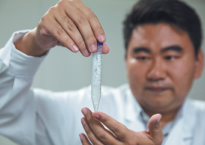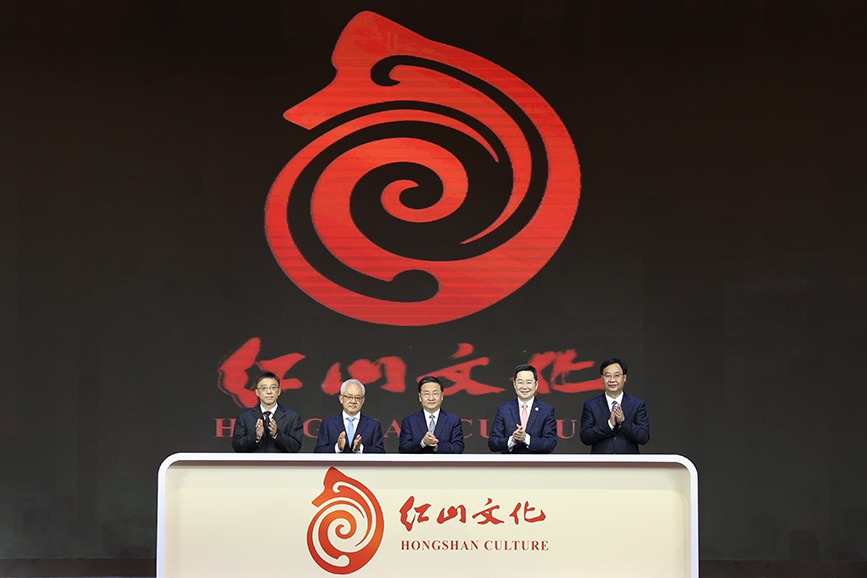Chinese scientists find new way to make starch

Chinese scientists have created starch, a type of complex carbohydrate found in plants, using carbon dioxide, hydrogen and electricity, according to a study published in the journal Science on Friday.
Experts said if such a technique can be scaled up to the level of industrialization, it may revolutionize how this key nutrient and industrial ingredient is made, since it does not require farming and processing large quantities of starchy crops such as sweet potato and maize, thus saving water, fertilizer and arable land.
It may also be used to recycle carbon dioxide, a common industrial waste and greenhouse gas, into a consumable product. This will help to reduce carbon emissions and combat climate change, especially if the electricity used is from renewable sources such as solar and wind.
In space exploration, it may provide a sustainable food source for astronauts as they travel long distances in space and try to reach other planets where growing food is unviable. Future space travelers may simply turn the carbon dioxide they breathe out into food they eat.
Ma Yanhe, director of the Tianjin Institute of Industrial Biotechnology of the Chinese Academy of Sciences, said starch and other complex carbohydrates make up of 60 to 80 percent of the human diet.
"Our breakthrough demonstrates that synthesizing a complex compound like starch is achievable in a lab, and there are many industries which can benefit from this technology," he said.
Starches are widely used in sugar production, food and beverage processing, printing, drugmaking, textiles, animal forage and dozens of other industries, according to Bric International Group, a global agricultural data firm. The manufacturing of cornstarch and its derivatives is currently an 80 billion yuan ($12.4 billion) industry in China.
Plants create carbohydrates like starch through photosynthesis, which is an extremely complex and inefficient process, said Ma, adding it would take a plant about 60 steps of metabolic reactions to turn carbon dioxide, water and sunlight into starch.
Cai Tao, one of the authors of the study, said his team has been focusing on a single project for six years: how to make starch like plants, but to do it much faster.
Creating carbohydrates via more effective means is so important for sustainability on Earth and future space exploration that NASA listed converting carbon dioxide to glucose, a simple sugar, as one of its centennial challenges in 2018. Starch is made of a much more complex chain of glucose molecules.
Cai said their method involves first converting carbon dioxide and hydrogen gas into methanol, a molecule containing a single carbon atom.
Scientists then piece these single-carbon molecules like a puzzle into bigger and more complex molecules via enzymatic processes.
With the help of supercomputing, Chinese scientists have streamlined the natural starch making process from about 60 steps into just 11, with the final product being starch. Cai said the lab-made starch is chemically identical to starch in nature, whose solution can turn blue with iodine.
"On July 24, 2018, our solution had turned light blue for the first time after hundreds of failed experiments. It was a great moment of introspection and awe because it proved our method had worked," Cai said.
"We overcame countless difficulties over the years, for us, that light blue in a tube shines like a bright ray of hope, signaling that all our hardship had paid off. Now blue is my favorite color."
With this new method, theoretically, a bioreactor the size of one cubic meter can annually produce as much cornstarch as a 0.33-hectare corn field every year, if the energy input cost is excluded, Cai said.
If the cost of this technique becomes economically viable, it could save over 90 percent of arable land and water resources used in agriculture, and avoid polluting the environment with fertilizers and pesticides.
Moreover, this method enables scientists to create highly specialized starch like the ones used in medicine tablets and pills, Cai added.
However, Cai said it may take scientists between five to 10 years to create an industrial demonstration of this new production method. "It cost hundreds of thousands of yuan just to create a few grams of starch in our lab because it requires a massive amount of electricity," he said. "But as we optimize our procedures, the cost will definitely go down."
Ma said if the industrial demonstration can reach an electricity-to-starch energy conversion efficiency of 41.6 percent, then it would translate to creating 1 kilogram of starch using 10 kilowatt-hours of electricity.
"This innovation will allow us to explore and create a green, sustainable industrial path that takes carbon dioxide as an ingredient to make carbon-neutral food, and then later expand into making fuel, materials and other chemical goods," he said.
Jiang Huifeng, a researcher at the Tianjin institute who also worked on the project, said this new method would ideally work in places where there is cheap, renewable energy and which are within the proximity of big carbon emitting industries such as coal-fired power plants and steel manufacturing.
"We need a large quantity of highly concentrated carbon dioxide for our technique, and if we can recycle the bulk of these emissions from big factories, it will help China achieve carbon neutrality by 2060," he said.
Meagan Phelan, the executive director of Science Press Package, said Science magazine was very proud to publish this important paper.
"This work could provide a pathway to our future industrial bio manufacturing of this important global substance," she said.
Jens Nielsen, a professor at Chalmers University of Technology in Sweden, said the work is an "amazing example about how we can use synthetic biology to address some of the large challenges we are facing in society".
Lee Sang-Yup, vice-president for research at the Korea Advanced Institute of Science and Technology in South Korea, said the current production method has room to improve with more optimized enzymes and bioprocess engineering.
"I think this is fantastic work demonstrating the great power of synthetic biology," he said.

Today's Top News
- China, Central Asia witness deepened economic, trade ties
- Xi's article on guiding economic, social development with medium and long-term planning to be published
- Restraint and dialogue vital to de-escalate Israel-Iran crisis: Editorial flash
- 'No Kings' protests across US target Trump policies
- China criticizes US tariff narrative as 'one-sided, misleading'
- Lai throttling democracy, freedom in Taiwan






























